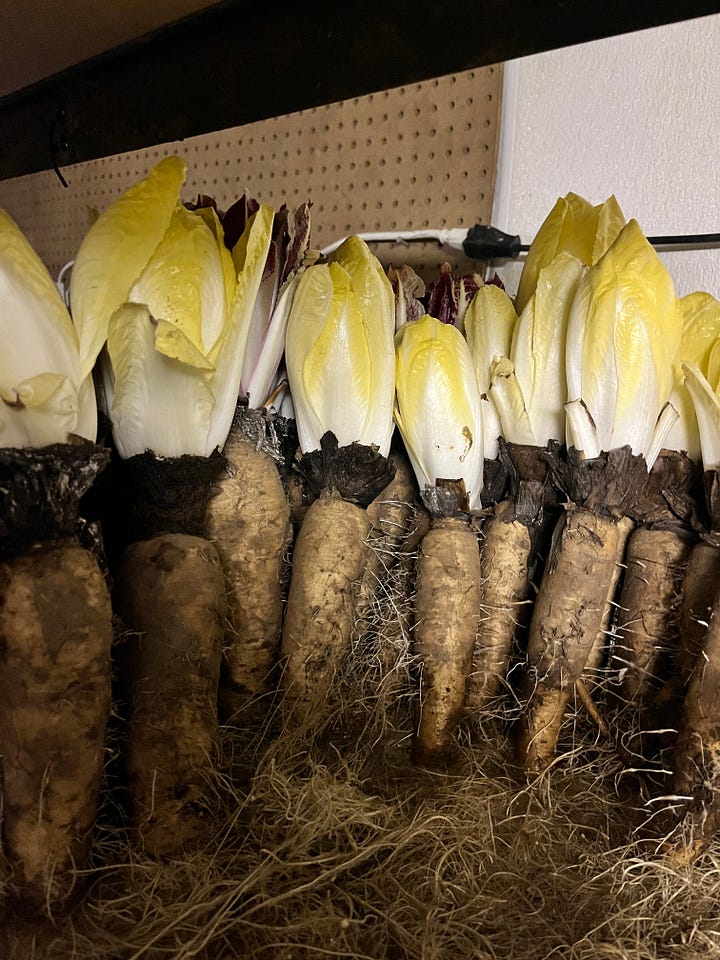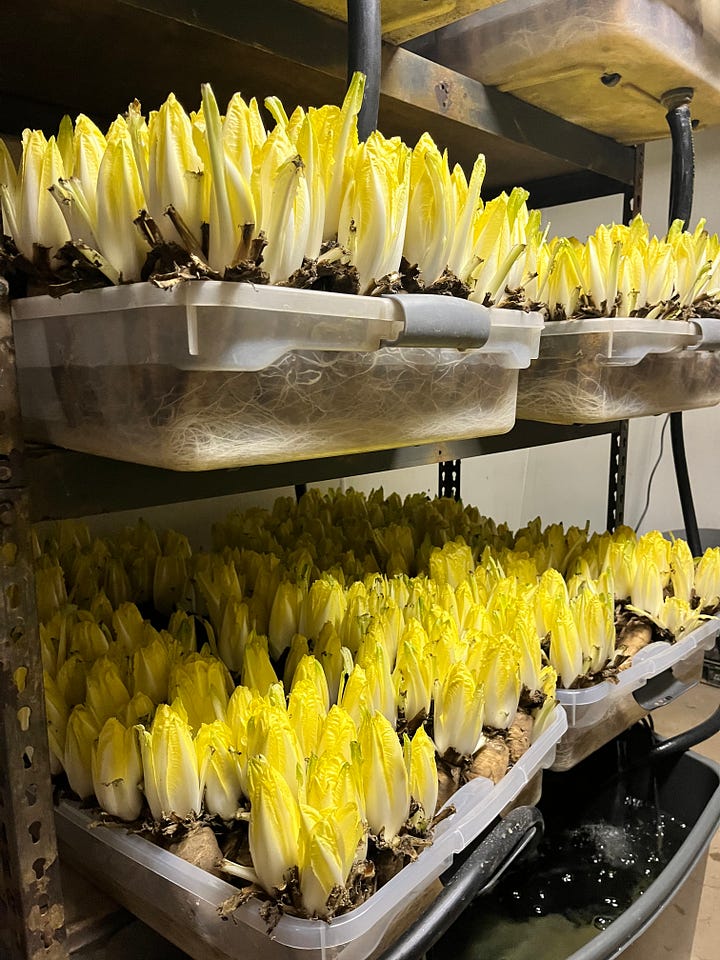In February, We Are All Belgian Endive
Winter in Portland, growing in the dark, focus, and all-out sprints (plus a West Coast-y Italian sounding recipe)
Etiolation (EAT-ee-oh-la-shun) happens to plants when they’re not getting enough light. Instead of using their energy to branch out and create leaves and blossoms, new growth essentially goes into an all-out sprint. Everything shoots in one direction, as fast as it possibly can, in the hopes of reaching light before the whole thing runs out of energy. Plants can’t even be bothered to make chloroplasts during this time. They’re just focused on one thing: Getting to the photons.
It’s not something to aspire to for your houseplants or new seedlings, but etiolation is a normal part of plants’ lifecycles. If you’ve ever dug up a sprouting acorn or unearthed a few bluebell bulbs in early spring before the shoots break the surface, you’ve seen that the first ghostly, fragile shoots of growth are always etiolated. It’s dark underground, after all. But it’s just a phase. Once they breach the surface of the soil, things change. Plant tissue exposed to light kicks into gear metabolically, greening up and starting to photosynthesize. In the process, it becomes tougher, darker, and more flavorful.
As a person slogging through her 39th February in the Pacific Northwest, I find myself highly sympathetic to the etiolated plant. This time of year can feel like a hatches-battened, eye-on-the-prize, blinders-up final leg of winter before the light returns. It’s always a drag, but this year has been a little extra, in that the state of the world feels particularly dire and I’m also sprinting towards the finish line of a big project: a book manuscript about radicchio that I’m working on with Lane Selman of the Culinary Breeding Network and food and farm photographer Shawn Linehan.
Getting to work with your friends on a huge creative project is a total dream. It’s also a Very Big Project, and the past several weeks have passed in a blur of that special state between focus and panic that feels very much like how I imagine etiolation feels to plants. Books, like new plants and pretty much any creative or personal human endeavor, start in the dark, are initially spindly and weak, and are invisible for a long time before anybody notices. Plus, there’s that imminent, callusing contact with unfiltered reality to contend with.
Still, there are many potential benefits of unbalanced, hidden growth. Etiolation is what gives us the elegantly contorted shapes of Treviso tardivo and the hot pink sweetness of forced rhubarb. It’s how white asparagus is grown and what gives mung bean sprouts their ghostly presence. From a culinary perspective, etiolated plant tissue is crisp, watery, and mild. Intense vegetal flavors like bitterness and astringency are toned down, although not entirely absent. I once ate a plate of pasta in the Dolomites cooked with bracingly bitter etiolated turnip sprouts, as piercing and keen as something unleashed from the underworld. But most etiolated ingredients are easy to like — especially Belgian endive, which I have a renewed appreciation for after visiting a Belgian endive farm in the Willamette Valley, one of just two in the United States.
Vissers Endive in Silverton, Oregon, is owned by Wim and Anja Visser, a Dutch couple who moved to Oregon several years ago. Wim grew commercial endive in the Netherlands, where it’s called witloof, and actually consulted on the other American Belgian endive farm, a much larger operation in California’s Central Valley. As far as I’m concerned, that makes Wim the leading national expert on Belgian endive. How cool. They sell at the Silverton Farmers Market and E.Z. Orchards’ Farm Market in Keizer, plus to distributors that bring their product into Oregon grocery stores like New Seasons and Roth’s.




Belgian endive grows in two phases. First, it’s planted in a field in the spring, like a regular crop. But instead of harvesting it like any other crop in the fall, it’s mowed down to an inch or so of stubble, then undercut about six or eight inches below the surface of the soil. From the field emerges bin after bin of endive roots, which look like a nubbly, muddy carrot. Those roots are stored in a cold walk-in for at least six weeks, and up to a year.
Over the course of the year, roots are brought out batch by batch into the forcing room, a dark, warm, fecund-smelling chamber lined with stacks upon stacks of burbling trays. Each one holds tepid flowing water and several dozen nubbly endive roots in various stages of producing their chicon, a fully etiolated bud of new growth produced entirely in the dark and harvested by headlamp. The roots can be kept for up to a year in cold storage before being sent on for forcing, which takes a couple of weeks. This means the Vissers can grow and harvest fresh endive year-round, a kind of seasonless vegetal spelunking for strange, pale jewels.
People say Belgian endive is bitter, but maybe after several months of daily radicchio eating it no longer reads that way to me. Instead, it tastes luxuriously crisp and a little bit meaty, and I find myself munching its long, cupped leaves with mindless pleasure like chips. I’ve been experimenting with braising it as the Dutch do, and I like that very much, but for me it’s a salad green first and foremost.
Insalata Tricolore Doppio
Portlanders get to use our amazing farmers markets and produce shops as a total crutch. All it takes to make a world-class salad is a bag of farm salad mix and a little bit of olive oil, vinegar, and salt. But you can still make a great salad from regular grocery store ingredients, and here’s one of them.
I recently came across a new-to-me word on Wikipedia: Italian Sounding, or making things seem Italian that aren’t by lavishly applying the green-red-white flag, Italian words, graphics, and other Italian-ish signifiers. I suspect that the Italian-American restaurant classic of the insalata tricolore — endive, radicchio, and arugula to echo the white, red, and green of the Italian flag — is a perfect example of this. That doesn’t diminish its excellence as a salad, however, which I think is significant.
This version doubles down on the color trio with not even a little bit Italian Sounding layer of avocado green goddess, pickled red onions, and white(ish) sunflower seeds. It’s like if the insalata tricolore as imagined by a West Coast salad bar. If you’re feeling a little etiolated yourself, use store-bought dressing or just toss in some cubed avocado, olive oil, and lemon juice and call it good.
One Belgian endive (or more!)
A big handful of bagged arugula
One quarter of a Chioggia radicchio, cored and shredded
Several slices of red onion, soaked briefly in hot water and then marinated in a 1:1 combination of vinegar and water with a big pinch of salt and sugar for at least 15 minutes.
A handful of roasted sunflower seeds
Avocado goddess dressing: In a blender, whirl up half an avocado, a hearty dollop of greek yogurt and the same amount of mayonnaise, one garlic clove, two anchovies, a big splash of lemon juice, salt, pepper, and a generous handful of whatever soft green herbs like parsley, tarragon, or basil you have on hand.
Slice up your endive into inch-ish wide crescents. Toss it with the other greens, toss all that with dressing, and then top with pickled red onion and sunflower seeds. Salt and pepper as necessary, then eat it at your desk straight out of the mixing bowl while trying not to look at the news on your computer.
Other work updates
Most of my professional energy is still going towards the book, but I also published a piece about my favorite romantic restaurants in Oregon for Travel Oregon recently, plus this really fun story with video about the Multnomah Whiskey Library. It was my second time working with Erick at EJD Visuals and Lorenzo at A Stella Visual on a combo editorial/video feature for Travel Oregon (the first was about the astounding MÄS in Ashland, watch close for my excellent hand/mouth modeling!), and it’s been very fun getting to collaborate with videographers.
I’m also wrapping up the spring issue of Distiller magazine, which includes a global editorial package focused on what distillers around the world think is coming down the pike in 2025. Spoiler: Nobody’s feeling hugely optimistic. Trade and tariffs are the biggies, but there’s a lot of hand wringing over decreased alcohol consumption globally. Personally, I think if everyone stopped drinking cheap grocery store wine and red state bourbon and focused their spending on drinking less but better from small producers that actually live in and support their shared communities, that’s a pretty positive outcome. Here’s hoping.
More optimistically, after a brief snow delay, I’m gearing up for several days at The Rice Place in early March to continue polishing this book manuscript. It’s a hand-built house writer Clyde Rice constructed on the banks of the Clackamas River in Damascus. Today artists and writers can reserve time there for creative work. It’s a wonderful resource in western Oregon that more people should know about.



